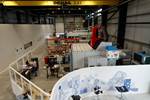FAA approves G-1 Certification Basis for Archer
The FAA’s approval enables Archer to move toward its goal of obtaining an FAA Type Certification for its composite all-electric vertical takeoff and landing aircraft.

Photo Credit: Archer Aviation
(Palo Alto, Calif., U.S), a developer of all-electric vertical takeoff and landing (eVTOL) aircraft has been actively engaged with the Federal Aviation Administration (FAA) to develop the airworthiness and environmental requirements necessary for full certification of its composite eVTOL aircraft. The FAA G-1 Issue Paper: Certification Basis (G-1 Certification Basis) has been approved and signed, enabling Archer to move toward its goal of obtaining an FAA Type Certification for its eVTOL aircraft.
The G-1 Certification Basis is based on the FAA's certification standards contained in 14 C.F.R. Part 23. The G-1 Certification Basis sets forth the specific Airworthiness Standards and Environmental Standards required for FAA Type Certification. With these requirements now established, Archer can focus on finalizing its G-2 Issue Paper with the FAA, which will set forth the means of compliance to meet the requirements set forth in the G-1 Issue Paper. Archer says it has been working on the means of compliance for the G-2 Issue Paper with the FAA since earlier this year, as well as the necessary testing and methods required to demonstrate safety and compliance of the aircraft.
Archer says that since its inception, the company has focused on ensuring its design, engineering and business decisions align to develop an aircraft that meets the FAA’s rigorous safety standards and achieve FAA Type Certification as soon as possible. According to the company, this achievement is the result of a collaborative relationship Archer has established with the FAA.
Archer’s head of certification, Eric Wright, says, “We’re proud to have hit this historic milestone for Archer. Obtaining the G-1 Certification Basis is a significant step forward towards Archer’s and the eVTOL industry’s goal of changing how people will move around urban environments.”
Related Content
-
Infinite Composites: Type V tanks for space, hydrogen, automotive and more
After a decade of proving its linerless, weight-saving composite tanks with NASA and more than 30 aerospace companies, this CryoSphere pioneer is scaling for growth in commercial space and sustainable transportation on Earth.
-
Plant tour: Airbus, Illescas, Spain
Airbus’ Illescas facility, featuring highly automated composites processes for the A350 lower wing cover and one-piece Section 19 fuselage barrels, works toward production ramp-ups and next-generation aircraft.
-
Combining multifunctional thermoplastic composites, additive manufacturing for next-gen airframe structures
The DOMMINIO project combines AFP with 3D printed gyroid cores, embedded SHM sensors and smart materials for induction-driven disassembly of parts at end of life.



